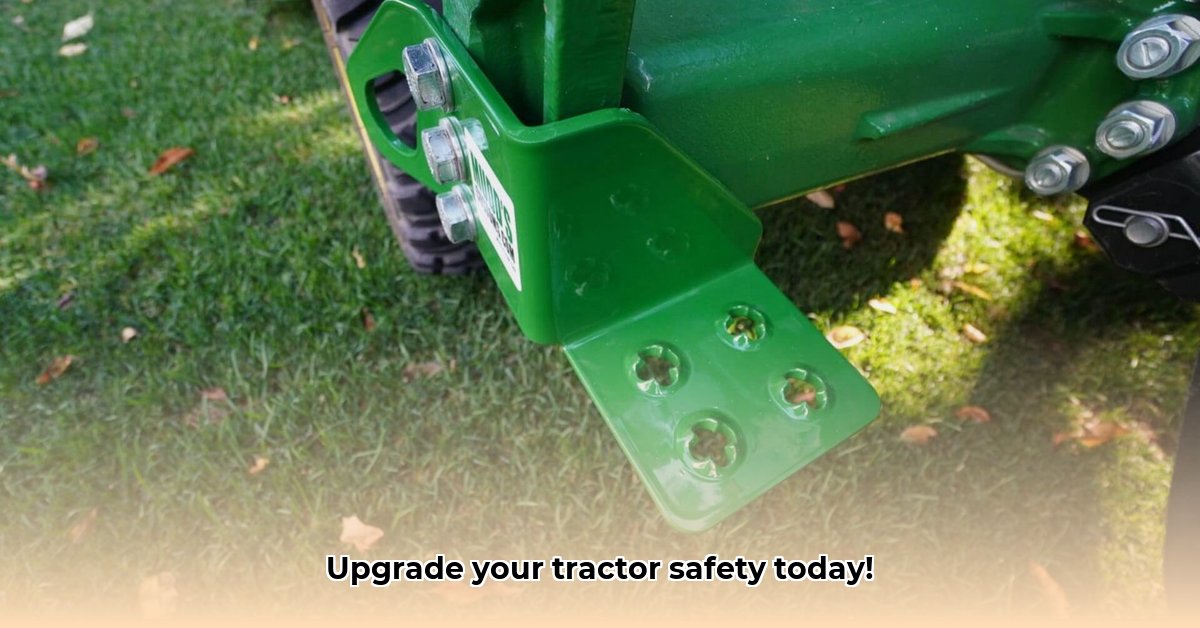
Getting on and off a tractor shouldn't be a risky maneuver. For farmers and agricultural workers, safe access is paramount. Bolt-on tractor steps significantly improve safety and convenience. This comprehensive guide will help you select, install, and maintain these essential safety additions for your equipment. We'll cover everything from choosing the right steps for your needs and budget to troubleshooting common problems. For more options, check out these tractor step options.
Choosing the Right Bolt-On Tractor Steps
Selecting the ideal bolt-on tractor steps involves several key considerations. Just like choosing work boots, the right steps depend on the job and your needs.
Weight Capacity: This is the most critical factor. Always consult your tractor's owner's manual for weight limits. The steps must comfortably support your weight plus any additional load you might carry. Exceeding the weight capacity is incredibly dangerous.
Material Selection: Steel and aluminum are the most common materials. Steel offers superior strength and durability but is heavier and susceptible to rust without proper maintenance. Aluminum is lighter, corrosion-resistant, and easier to handle, but may be less robust. Climate and tractor usage will influence your material choice.
Mounting Style: Different tractors have varying frame designs. Ensure the steps' mounting style is compatible with your tractor. Carefully check manufacturer specifications for a secure fit. Incorrect mounting can compromise safety.
Size and Comfort: Choose steps appropriately sized for your height and the tractor's design. Adequate width provides a stable footing, while sufficient height ensures easy access. Comfort contributes to safe and efficient use.
A Quick Comparison:
| Feature | Steel Steps | Aluminum Steps |
|---|---|---|
| Strength/Durability | Very strong, long-lasting | Strong, but potentially less durable |
| Weight | Heavier | Lighter |
| Price | Generally less expensive | Generally more expensive |
| Maintenance | Requires regular cleaning & rust prevention | Less maintenance needed |
| Corrosion Resistance | Susceptible to rust | Naturally corrosion-resistant |
Don't forget to consider ease of use and overall sturdiness. A poorly designed step, even if strong, can be dangerous.
Installing Your Bolt-On Tractor Steps: A Step-by-Step Guide
Installing new steps is relatively straightforward, but safety remains paramount. Always disconnect the tractor's battery before beginning any work. This crucial step prevents accidental starting and injury.
Step 1: Preparation: Carefully read the manufacturer's instructions. Gather necessary tools (typically a wrench or socket set). Thoroughly clean the tractor's mounting area to ensure a secure bond.
Step 2: Precise Placement: Position the steps for optimal access and safety. Take your time; double-check placement before drilling or bolting.
Step 3: Secure Mounting: Use supplied hardware to securely attach the steps to the tractor frame. Tighten bolts to the manufacturer's specified torque. Overtightening can damage threads or the equipment.
Step 4: Thorough Testing: Before operating the tractor, test the steps for stability. Shift your weight to confirm secure attachment. If anything feels loose, recheck and tighten bolts.
Important Considerations: If you feel uncomfortable with any installation aspect, consult a qualified mechanic experienced with tractor maintenance.
Maintenance and Care: Ensuring Long-Term Safety
Regular inspections and maintenance extend the lifespan of your steps and ensure continued safety.
- Regular Inspections: Regularly check for loose bolts, rust (especially on steel steps), or damage. Tighten loose bolts immediately.
- Cleaning: Clean steps regularly to remove mud and debris, preventing corrosion.
- Corrosion Prevention: For steel steps, apply rust inhibitor or protective coating, especially in humid climates.
These simple steps will keep your bolt-on tractor steps safe and functional for years.
Troubleshooting Common Issues
Despite their robustness, occasional issues may arise. Here are common problems and their solutions:
- Loose Bolts: Tighten securely, avoiding overtightening.
- Bent or Broken Steps: Replace damaged steps immediately; using them is unsafe.
- Difficult Installation: Refer to manufacturer instructions or seek expert help.
Always prioritize safety. Never use damaged or improperly installed steps.
Safety Regulations and Compliance
Comply with all relevant local safety regulations. These regulations vary by location, but the core principle remains: steps must be sturdy, securely mounted, and regularly inspected.
Product Reviews: Informed Purchasing Decisions
Online reviews offer valuable insights into user experiences and product performance. While specific product endorsements are beyond the scope of this guide, comparing several models based on user feedback about ease of use, sturdiness, and overall satisfaction will prove valuable. Note that lower-priced options sometimes compromise on durability—prioritize safety over cost.
Key Takeaways: Prioritizing Farm Safety
- Factory-installed steps are often inadequate, highlighting the need for upgrades.
- Aftermarket steps significantly enhance safety and accessibility.
- Material, weight capacity, and secure mounting are critical for safety.
- Proper installation is essential to prevent accidents.
- Regular maintenance is key to extending step life and ensuring continued safety.
This guide provides a comprehensive framework for enhancing tractor access safety. Remember to always prioritize safety and consult professional advice when needed.